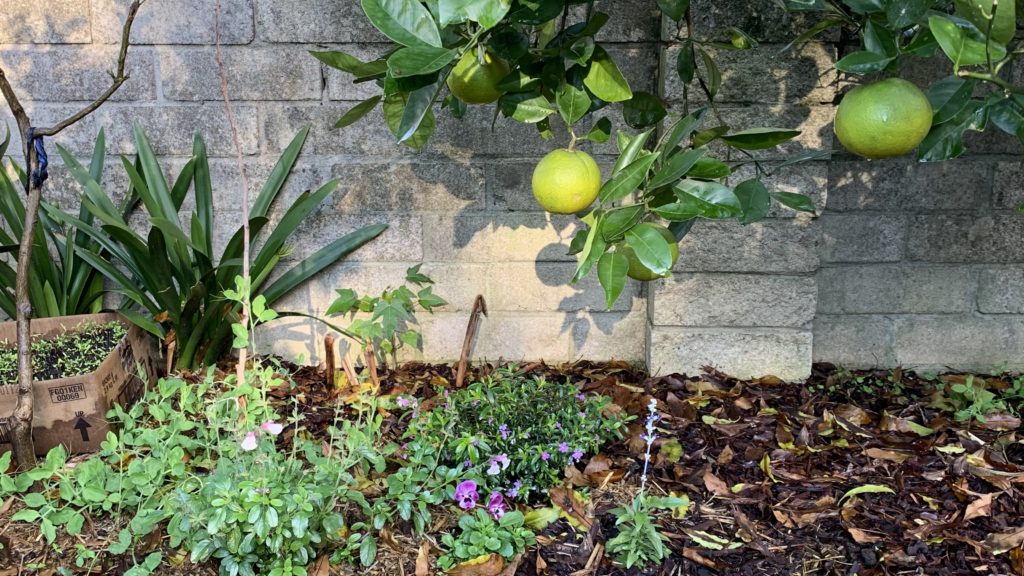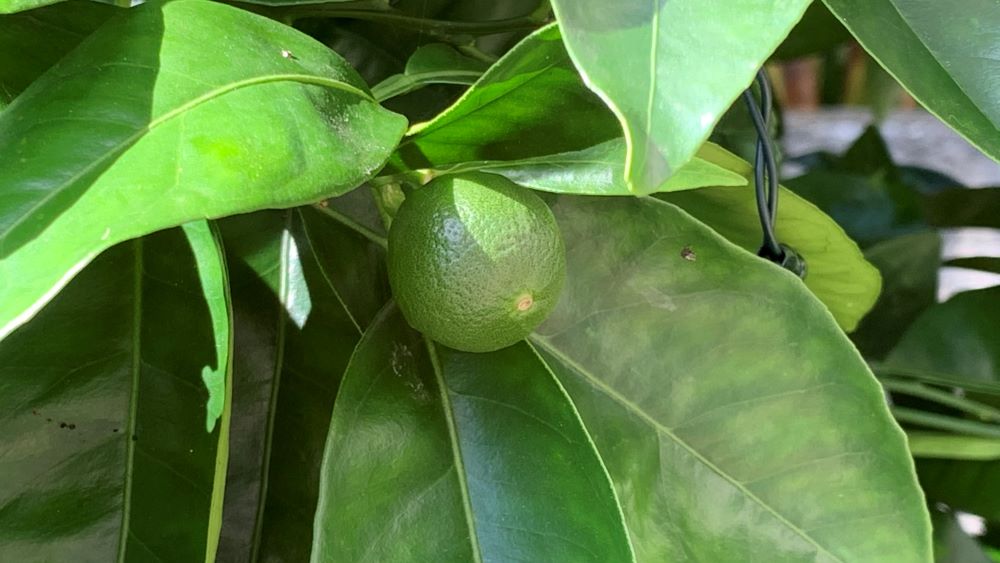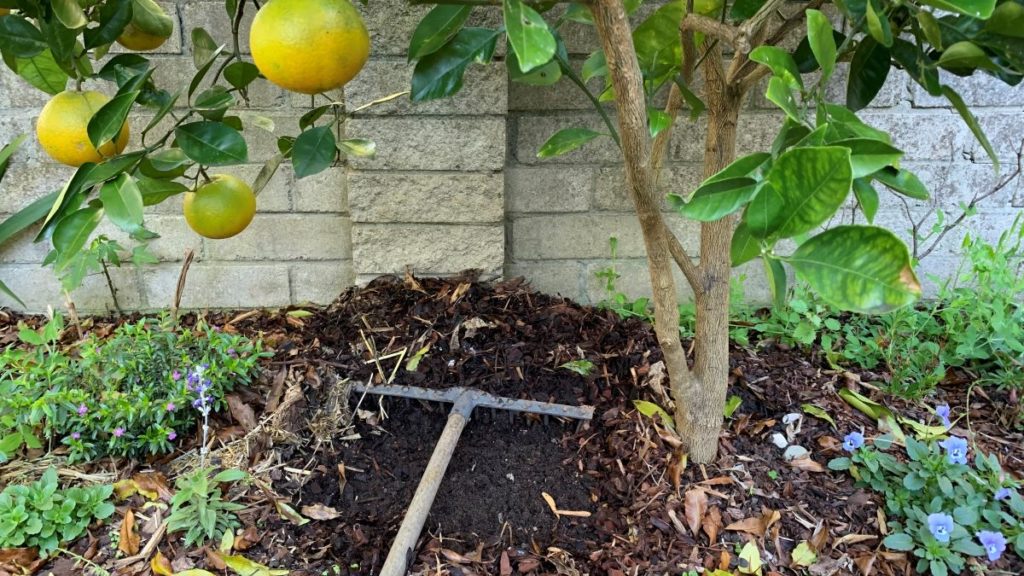Orange trees can survive winter if you prepare them well and if the temperature stays above 41 degrees for most of the winter. Orange trees are cold tolerant but can be damaged if it snows or there are heavy frosts. Oranges will withstand colder temperatures than other citrus such as lemons and limes so are a great choice if you get cold winters.
This article will explore what to do with orange trees in winter, how to protect them from very cold weather and how to grow more fruit and healthy leaves and stems.

What to do with orange trees in the winter
There are three things that you must do over winter to help your orange tree to thrive and grow fruit. Mulch water and pest protection are important steps to keep your orange tree healthy.
1. Mulch
Mulch is important for orange trees over winter. It helps to protect the soil, protect the orange tree roots and prevent winter weeds. The mulch will keep the soil at a consistent temperature and help to protect soil bacteria.
Mulch orange trees over winter by adding a 2-3 inch layer of bark mulch. This mulch breaks down slowly and feeds soil bacteria and worms. This protects the roots but will still let rain through.
You can also use straw or sugar cane mulch which can protect the soil. The main difference is that it will break down quicker and need to be replaced by the start of spring. It has all the same benefits of bark mulch but will need to be replaced more often.

2. Water
Consistent water is important for orange fruit development and a healthy tree over winter. If you get regular winter rain then you will only need to water your orange tree around once per month. Check the soil and if you are having a dry winter, water the tree every 2 weeks.
Water around the base of the tree in the morning but keep the water away from the trunk. Water the tree deeply all around the root base.

3. Pest protection
Pests can move in and attack new growth that forms on the tree at the start of winter. Aphids can attack small green stems which can also attract ants as they squirt out honeydew. This sticky substance can see you have ants all over the tree in no time.
Aphids can be left for a day or two to be eaten by ladybugs but if there are too many you may need to reach for a horticultural oil. Spray with neem oil to remove the pests and spray again in a week if they are still there. This will save your new growth and keep your tree looking healthy over winter.

How to protect an orange tree for a winter
Preparing an orange tree for winter is really important to help it survive colds snaps and frosts. Here are my top 3 ways to prepare an orange tree for winter.
1. Top dress
Top dressing an orange tree in fall will give it the protection it needs for the winter months. Mix together some aged cow manure and compost in a bucket or wheelbarrow. Use a rake to move the mulch back from the root zone of the orange tree carefully.
Scatter the compost and cow manure mix on top of the root area and flatten it out to around 2 inches thick. Cover this top dressing with mulch and rake it flat. Water it in well and your orange tree will be fed and protected ready for new growth and to set new flowers and fruit over winter.

2. Fertilizer
Adding fertilizer in fall will help to prepare the tree with enough nutrients for the winter months. Use a balanced organic based fertilizer like pelleted chicken manure or a fertilizer designed for citrus trees. Orange trees will flower and set their fruit in late winter so they will need the extra nutrients.
3. Prune
Pruning the orange tree to shape in fall will keep it looking neat over winter. Take care to only remove branches and stems that are damaged, crossing over or pointing downwards. Taking off too much can reduce your harvest as this growth will be where the new flowers and fruit will sprout from.
Fall is a great time to remove any damaged branches or leaves that have been eaten by bugs.

Leaving an orange tree outside in winter
Orange trees will thrive outside in winter where the weather is dry, cool and generally frost free. While they can survive some frosts, frequent cold weather can be too much and damage leaves and flower buds.
For very cold regions it can be best to grow orange trees in pots and move them into a greenhouse over winter.
Protecting young orange trees in winter
Young orange trees will be more sensitive to cold winters so the best way to prepare them is to plant them fall or spring. This will give them enough time to establish their root systems before the weather turns cold.
Surround the base with a thick layer of straw over winter to act like a blanket to protect their sensitive roots. Liquid seaweed given every 2 weeks in fall will also help the roots to develop quickly and improve the soil. A strong root system is key to a healthy plant that will survive its first winter.
Can orange trees survive winter? | Summary
Orange trees can survive and thrive over winter and add new growth, flowers and fruit. Set them up for spring fruit and protect them from frosts using mulch. Add water each month over winter if you are not getting regular rain. Fertilize the tree with pelleted chicken manure in fall to set them up for growing flowers and fruit in winter.
Orange Tree Articles
- How to Save a Dying Orange Tree | 7 Easy Steps
- Can orange trees survive winter? | Protect them from a winter FREEZE!
- Are orange tree roots invasive? | How far do they spread?
- Why do my oranges taste like lemons? | How to make them SWEET!
- Why is my orange tree dropping leaves? | + Easy solutions
- Orange tree is not blooming | 10 Problems and easy solutions
- How to pick oranges from a tree | Tips & Tricks
- Companion plants for orange trees
- Oranges not ripening on the tree | Why & What to do
I am an accredited practicing dietitian, experienced gardener and a dedicated cook. I love writing and sharing my experience so you can learn from my successes and mistakes.
